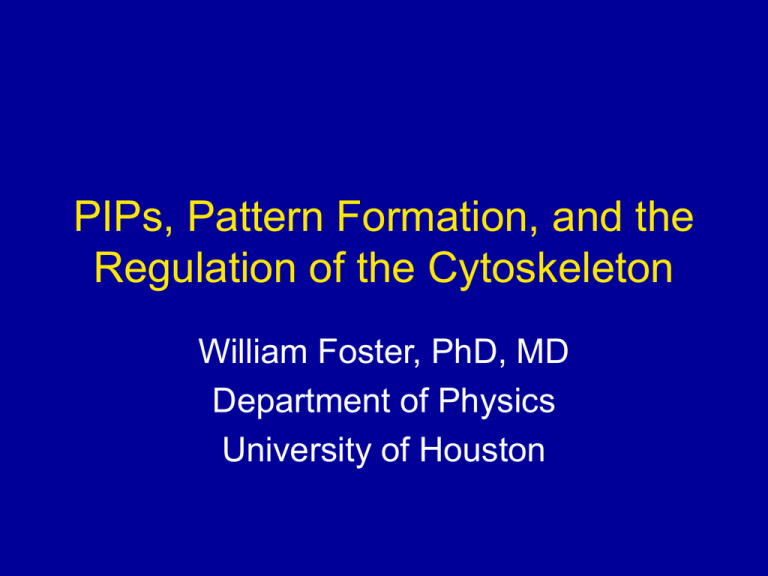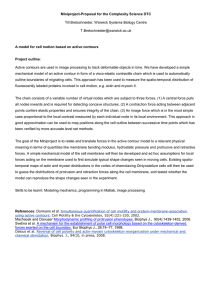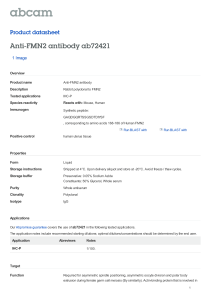PIPs, Pattern Formation, and the Regulation of the Cytoskeleton Department of Physics
advertisement

PIPs, Pattern Formation, and the Regulation of the Cytoskeleton William Foster, PhD, MD Department of Physics University of Houston How Cells Crawl Some reasons why this problem is medically important human polymorphonuclear leukocyte (neutrophil) on a blood film, crawling among red blood cells and "chasing" Staphylococcus aureus microorganisms C. Cunningham, MD Listeria An INTRAcellular organism. Triggers actin polymerization at its trailing edge Melanoma Usually grows slowly but kills patients because it can spread to the liver, brain and other parts of the body. Human platelets Changes in cell shape are due to changes in the cytoskeleton What is the cytoskeleton? • The “skeleton” of a cell • Made up of actin – a protein – Simplified in this talk Regulation of the cytoskeleton • Actin monomers “Gactin” are added to the growing end of an actin filament “Factin” • Monomers fall off of the other end • This process is driven by ATP J. Käs, PhD What is happening at the membrane? • Proteins (gelsolin and profilin) cap actin filaments and prevent further grown • Removal of these proteins allows elongation of filaments What is happening at the membrane? • These proteins are regulated by CLUMPS of highly charged lipids How is actin regulated? • The cell membrane plays a critical role both in the regulation of the actin cytoskeleton as well as many other processes • The actin polymers elongate at the membrane – Wouldn’t want them to elongate in the middle of the nucleus or near the DNA T Stossel, MD Not part of this talk! What do we know about how the cytoskeleton works? F-actin (polymerized actin) in the lamellipodia is (fluorescence labeled) GFP-Actin. Intermediate Summary • Actin is a protein that polymerizes to form much of the cytoskeleton. • Some proteins that regulate the cytoskeleton are regulated in part by lipids (PIP) in the cell membrane. • We want to understand the effect of these highly charged lipids (PIP) on cell membranes. • We will now talk about some soft condensed matter concepts and techniques that will allow us to study this problem. Lipids PC PI PI(4,5)P2 Why PIP • Usually a few % of total lipid in biological membranes • In vitro, several proteins require 10 mole% • Specialized regions of the plasma membrane (caveoli or lipid rafts) may be highly enriched (>20%) in PI’s • This clumping of PIs may be important Imaging Membranes Lens PC Texas Red - PE NBD-PIP2 1 mm PA Janmey, PhD Inject soluble factors into aqueous phase What is the effect of these highly charged lipids (PIP) on cell membranes? • Start with a lipid film – contains varying quanties of PIP – Contains 1% fluorescent probe • Image the lipid film Line Tension • There can be domains of different phases – say, differently ordered phases • Domains have line tension – The 2 dimensional analog of surface tension • Domains in a film are round because that lowers the energy of the system • The bar is 100 microns Changes in line tension with PIP concentration (0%, 10%, 50%, 90%) Addition of NaCl to screen electrostatic interactions The labeled lipid in the prior slides also contains PIP Line tension no longer dominates the shape of lipid domains The free energy of the system is: F dr 2 2 dA' dA 2 dA' dA 3 2 r r' r r' Where: =the line tension is the dipole density is the charge density DJ Keller, JP Korb, HM McConnell, J Phys Chem 91 (1987). DJ Keller, HM McConnell, VT Moy, J Phys Chem 90 (1986). HM McConnell, VT Moy, J Phys Chem 92 (1988). Consider evaluating this equation on an ellipse • Using Green’s theorem: 2 2 dr ' dr F A ( 2 ) dr 2 r r' 2 Where: = the electrostatic energy/unit area L = the line tension = the dipole density = the charge density dA' dA r r ' Evaluating the energy in terms of the complete elliptical integrals 2 2 dr ' dr 4 ab 4aK (k ) F A ( 2 ) E (k ) 2 r r ' 3 2 where k b 1 a K(k) is the complete ellipital integral of the first kind E(k) is the complete ellipital integral of the second kind Expand in powers of D=ln(b/a) • • • • • F=e0+e2D2+e4D4+… e4>0, otherwise the system is unstable. If e2>0, the minimum is at D=0 If e2<0, the minima are at +e2/2e4 The system undergoes a second order phase transition from a phase where round domains minimize the energy to a phase where distorted domains are favored. 4(ab)1/ 2 2 (ab)1/ 2 2 (ab) 2 2 3( ) 2 ln 10 / 3 e2 0 16 2 e d Summary • The cytoskeleton is a rich topic for biological physics research. • Powerful techniques have been developed to study this system. • We can quantatively understand the effect of different constituents to the structure of cell membranes Thank you • Paul Janmey, PhD (U. Penn) • Josef Käs, PhD (U. Leipzig)




